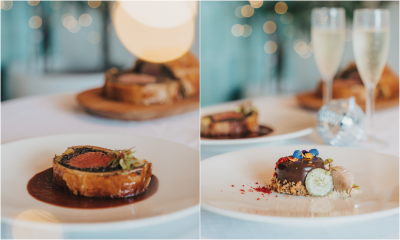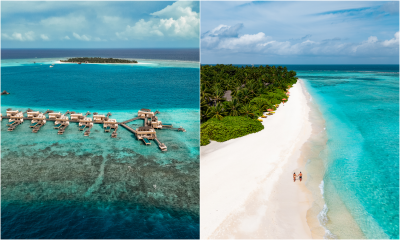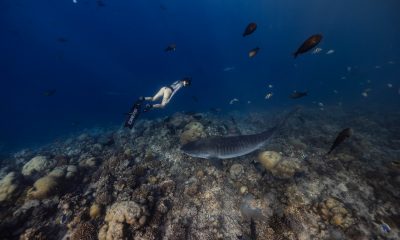Island Goers
The Hidden Fountains of Paradise

Maldives Promotion House – A southern most haven in the paradise of Maldives, completely secluded from the rest of the country composed of a geography that contrasts with the rest of the archipelago, Fuvahmulah is an atoll island with natives that speak their own dialect of the Dhivehi language of Maldives. Roughly five kilometers by one kilometer with a submerged reef that extends for about three kilometers south east, the island is surrounded by coral boulders and rough waves.

Perhaps the most intriguing features of the island are its two lakes formed from the ancient lagoon in the center of the island. According to the locals the southern end was open, providing a channel connecting the ancient lagoon with the ocean. Due to violent ocean swells and the lack of an outside lagoon the only way into the island was through this channel, providing protection against pirates. However the channel was closed by coral growth and collection of debris. Over the ages, the inner lagoon lost its salinity and all that remains today are two small fresh water lakes, wetlands and marshy taro fields.

Research into the lakes show that the bottoms of the lakes are filled with decayed corals that have turned into white clay. The forefathers of the locals used the clay to shape it into pots and other vessels. The protected lakes are still lined with a thick layer of clay covered by a pinkish layer of minerals known to the locals as “Rai Madu”. The lakes are now listed as protected areas under the law. The locals use the area to spend time with friends and to enjoy. The natives have always spoken of and believed in the heart of their hearts, of the healing abilities of the lake water. Further research into the lake water shows that the water is filled with minerals and perhaps more healthier than mineral water.
The smaller northern lake, known as “Dhandimagu Kilhi”, is preferred by locals who often use the area for recreational and enjoyment purposes during holidays. Picnics are common and local youth often use the lake for swimming. Since the lake is also home to an abundance of small fresh water fish, the lake was used for leisure fishing as well. While damaging the area or disrupting their natural beauty is prohibited by law, the lakes can be used for recreational purposes such as swimming. The tall reeds that grow around the marshy wet land and lake are used to weave mats among other uses.
One of the natives told us a tale, of how his son was healed by the water. “My son has a skin condition, his skin dries and cracks up very quickly. I couldn’t find a permanent cure. So I took him to the lake. We played and swam. We had fun and we were happy. After we returned I found out that his skin was beginning to get better. Within the following week, his skin had healed and he was perfectly healthy,” a native from “Fuvahmulah” told us his experience of the lake water.
The much deeper and bigger southern lake known as “Bandaara Kilhi” is usually left alone. During earlier times the lake was used for swimming and different areas of the lake were named after different houses of the island. While visitors and locals do visit the lake for its blissful scenery and natural beauty, locals usually don’t use the lake for swimming due to its depth. According to the natives, during ancient times the lake was used to store their harvest and gatherings to keep them safe from animals and pests. The local tales speak of a hut that was built at the center of the lake on stilts. The wooden stilts are still visible beneath the water surface. The fruits and vegetables that were harvested and gathered were then stored inside the hut for transportation to the capital Malé.
The locals also used the “Bandaara Kilhi” to culture fresh water fish. The lake fish was earlier used as food during low fisheries and rough seas. The two lakes of Fuvahmulah can also be used as a tourist attraction as the whole island is unique in its geography. While the island is full of natural beauty and a rich cultural heritage it is a wonder to be beheld. It is a community of people that lived for a long time depending only on the surrounding resources, and separate from the rest of the country. Being isolated they have developed a very different kind of unity, as rather than just islanders they are brothers and sisters.
The lakes are filled with tales of unimaginable romance and happiness. A native told us of his teenage romance tied to the lakes. He began his enthusiastic tale saying that “I was with my girlfriend when we met a friend of mine also with his girlfriend. They were sitting under one of the huge mango trees.”

“The fruits were ripe and they were enjoying the mangoes fresh from the tree. After we had some mangoes we decided to visit the lake. So I went home, changed my clothes and met them at the lake,” he paused as if lost in thought.
“We had fun as we moved through the wet lands spread out in all directions. We collected wood and barbecued while we cooked some soup. After we enjoyed our meal, we climbed one of the tall trees and made a flag out of a shirt.”
“Then we went into the forest and we would lose ourselves in its natural beauty. It is really difficult to find your way through the forest. But eventually we did, as the flag would show us the way,” I could see the glow in his eyes as he reminisced over his past.
“Afterwards we swam through the lake. I would make my way through the shallow water dragging my girlfriend along, as she floated on the water with her hands around my neck. It was pure bliss, swimming through the water is like a natural spa experience. There is nothing quite like it,” he spoke of those moments engraved in his memory.
“With the clear blue sky spread above, and the fresh lake water spread all around you, as you bask yourself in the warmth of the sun, those memories become etched in your mind. The lake is the heart of our community. It ties the bond between every romance, every family and every person. It is the glue that holds us together.”
Featured
Medhufushi Island Resort marks National Day with Maldivian heritage showcase

Medhufushi Island Resort recently marked Maldives National Day with an immersive celebration of Maldivian heritage, transforming the resort grounds into a living museum that reflected the country’s cultural roots. The event recreated the atmosphere of a traditional island village and offered guests the chance to experience authentic island life through interactive activities, performances, and storytelling.
The resort team constructed a replica village featuring ancestral-style houses and traditional architecture that demonstrated the resourcefulness of early island communities. Guests explored the structures and learned how Maldivians adapted to their environment over generations. The experience was enhanced by a variety of activities, including food stalls that served traditional dishes, demonstrations of local craftsmanship, and opportunities to take part in games once enjoyed by island families. Musical traditions were brought to life with the sounds of Bodu Beru drums, where visitors not only observed but also participated alongside local performers.

Cultural performances formed the highlight of the evening, with local women presenting traditional dances that narrated stories of island life and men delivering energetic Bodu Beru drum sessions. Guest participation was strong, with many joining in the dances and trying their hand at drumming. One visitor remarked that it felt like stepping into another time and described learning Bodu Beru from locals as an unforgettable experience.
Resort Manager Iyaz explained that the event is organised annually to preserve and share Maldivian heritage with visitors, noting his pride in the team for creating such an engaging showcase and expressing gratitude to the guests for their enthusiasm.
The celebration reflects the resort’s ongoing commitment to promoting cultural preservation through tourism, ensuring that traditional practices remain visible and valued. By offering authentic experiences, Medhufushi Island Resort connects guests with the history and identity of the Maldives while supporting sustainable tourism.
This annual showcase serves not only as entertainment but also as a bridge between past and present, reinforcing the importance of cultural continuity. Through initiatives such as these, the resort demonstrates how tourism can help protect traditions and foster community pride, enabling visitors to leave with more than memories of beaches and scenery, but with a deeper understanding of the people and heritage of the Maldives.
Island Goers
Mouni Roy’s enchanting birthday celebration in Maldives at Coco Bodu Hithi

Bollywood Actor Mouni Roy recently celebrated her 39th birthday in the most picturesque way possible, surrounded by the serene beauty of the Maldives. Accompanied by her husband, Suraj Nambiar, and close friends, Mouni’s birthday festivities were nothing short of magical. She shared glimpses of her celebration on Instagram on October 1, giving her fans a peek into her tropical retreat at the luxurious Coco Bodu Hithi resort.
A Tropical Birthday Bash
Mouni Roy has been soaking up the sun and enjoying the breathtaking views of the Maldives. Her latest Instagram updates have left fans in awe, showcasing her stunning vacation style. In one of her posts, Mouni looks absolutely ravishing in a pink bikini paired with a flowy white skirt. Posing effortlessly on a chair, she exudes confidence and charm, her sun-kissed skin and luscious, flowing hair adding to her radiant look.

Instagram Highlights
The actress shared several posts from her stay at the resort. In a video, she can be seen enjoying the resort’s over-water villa and pool, dressed in a stunning red beachwear. She captioned the post, “Loving it at @coco_resorts #cocoboduhithi #cococollection #cocomaldives #cocollectionmaldives #birthdaygateway.”
Another heartwarming photo featured Mouni with her husband, captioned, “Love & gratitude is all I feel in my heart. Ty so much for all the lovely wishes ♥️ #grateful #thankful #blessed.”
https://www.instagram.com/p/DAkjB2RNjf_/

Memorable Experiences
Mouni also shared a video reflecting on her incredible stay, captioned, “Just returned from an incredible stay at Coco Bodu Hithi Maldives with the Mr & friends, and I can’t stop reflecting on the amazing experiences we shared. Snorkeling in those crystal-clear waters was meditative; the vibrant fishy life left us in awe. 🐠 🌊 One of the highlights was the unforgettable birthday dinner they organized on the beach. The setting was simply magical, with soft sand beneath our feet and the gentle sound of waves. We kept lying down on the sand looking up at the stars. You all took such great care of us, made the evening feel special and intimate. Spending three days immersed in the ocean was rejuvenating, and every moment was filled with laughter and joy. Grateful for these memories and the beautiful bond we share. Until next time, paradise! X @coco_resorts.”
In another post, she expressed her longing to return, captioning it, “Take me back already!!!”
Mouni Roy’s birthday celebration in the Maldives was a perfect blend of relaxation, adventure, and heartfelt moments, making it a memorable occasion for her and her loved ones. Her fans are eagerly awaiting more updates and stunning visuals from her tropical getaway.
Culture
Palace for the prince: Muleeage’s century-long journey through history

It was ‘honeymoon season’ in Suez. Sultan Haji Imadudeen was reigning on a throne of love in Egypt. But back home, those were darker times, as Maldives continued to borrow from Bohra merchants of Mumbai. After all, the wedding expenses of the monarch had to be paid by the state.
Imadudeen has appointed his younger brother, Dhoshee Manippulhu of Maandhooge, as the regent to take care of the state’s affairs, but it was Prince Ibrahim Dhoshimeynakilegefaan of Athireege who ruled. Prince Ibrahim’s son, Abdul Majeed Didi of Athireege, took charge of stabilising the nation.
Backed by the British masters and business elites in Male’, Abdul Majeed Didi began hatching a secret plan. Finally, by the early hours of March 10, 1910, onlookers could understand that something was happening in Muleege. Beeru Mohamed Fulhu, who was at the Friday Mosque, saw the door being opened and Mohamed Shamsudeen being escorted out by his brother-in-law Abdul Majeed Didi and Sayyid Kilegefaanu, also known as Khatheeb Seedhi. The two men accompanied Shamshudeen to Boduganduvaru, the royal palace, and placed him on the throne as Sultan Shamsudeen Iskandhar, Al-Salitc. As Shamsudeen was the brother-in-law of both men, the aim behind the plan could mean more than just stabilising the nation; there might have been personal motives and interests.
After appointing Shamsudeen the sultan, Khatheeb Seedhi told him that no one was ever going to challenge his reign. He said that Shamshudeen was not going to leave the throne unless he wished to do so.
Khatheeb Sidi’s saying became true, as Shamsudeen remained in power for the next 31 years, six months and 28 days. That was until he left behind all the privileges of a king for the sake of his beloved son Hassan Izzuddeen, for whom he built Henveyru Ganduvaru or Muleeage from where he started his journey to become the sultan at one midnight. As the famous public speaker and poet Ibrahim Shihab later said, the sultan abdicated for the only son he ever had.
Muleeage, the presidential palace which is now 105 years old, was originally built for Shamsudeen’s son and the then Crown Prince Hassan Izzudeen. The palace was originally named as Henveyru Ganduvaru. It was a symbol of the king’s love for his son.
The origin of this address goes back to the era of the heroic Sultan Hassan Izzudeen, also known as Dhonbandaarain. This plot of land was first used to build a thatch hut when Muhammad Manik of Mulee shifted his family to the capital city. The house was later inherited by Dhonbandaarain and then by Ibrahim Noorahdeen and then by his son Shamsudeen. Hassan Izzudeen was born to Shamsudeen and Sithi Didi, daughter of Bodu Sidi of Kalhuhurage.
When Izzudeen was studying in Ceylon, Shamsudeen decided to build the house before his son returned home. Shamsudeen decided to build it as a palace for the crown prince.
Fully funded by state coffers, the project was commissioned in 1914. Ahmed Dhoshimeyna Kiligefaanu of Athireege was assigned as the project manager. Architects and builders were brought from Ceylon. Architecture and the design was that of the Victorian era with a touch of colonial architectural design. Furniture too was imported from Ceylon. Few transoms were designed by Easa Mohamed Fulhu from the island of Kela in Haa Alif Atoll.
The palace was opened on December 7, 1919, with a special Mauloodh, a cultural prayer.
Izzudeen came back from Ceylon after his education to live in the palace as “Henveyru Ganduvaru Manippulhu”. He lived with privileges that don’t match with that of any other prince. As he was a highly-skilled musician, the palace became a theatre for music. Izzudeen sang with his beautiful voice whilst also playing harmonium. Boys of his dance group, widely known as “Nashaa Party” danced to his music, dressed as ladies. Boduberu too was part of the fun at the palace. It was full on partying till midnight on most days. It is said that the novel, Dhonthuhkalaage Gellunu Furaavaru (lost teenage of Dhonthuhkala), written by Muhammad Ismail Didi of Meerubahuruge, was based on an incident that happened at the palace.
The elite of Athireege took all that as inappropriate for a crown prince. Their disapproval grew and Izzudeen was considered as someone who is ineligible for the throne. The first written constitution in the history of Maldives was passed as a result. It was written in that constitution that the sultanate will only go to a grandson of Dhonbandarain, effectively removing Izzudeen from the royal inheritance path.
But the constitution was later received by the people as a burden, as new laws were introduced to a population that was not aware of such rules. It made their life miserable.
“We can’t bear this anymore,” they said, as they gathered at the Gulhakulhey Fasgandu, an open area just next to the headquarters of the army, and tore apart the document. They even attempted to bring out some ministers to be dealt with by the mob.
The country then saw increased hostile actions against the government from Izzudeen who tried to take over.
Prime Minister Hassan Fareed issued orders to arrest Izzudeen’s allies. Izzudeen went to Bodubandeyrige, then headquarters of security forces, in person to try save his allies. Shamsudeen left the throne to follow.
The prime minister, who was paving way for the change in government, used this as an opportunity to overthrow Shamsudeen. The latter was banished to Fuvahmulah, in the far south, together with his son Izzudeen.
Izzudeen died on the island after a short ailment, whilst Shamsudeen was brought back to Male’ as his health deteriorated. He died shortly thereafter. Henveyru Ganduvaru was deserted after that.
All the palaces except that of the sultan were later downgraded and Henveyru Ganduvaru became Muleeage, taking the name of the first house built at the address.
Muleeage was used for several purposes for the next 80 years before becoming the presidential palace in 1953. From 1942 to 1947, it was used to house the ministries of home affairs and defence, and the office of the head of intelligence. It also served as the headquarters of the first newspaper in the country, Sarukaaruge Khabaru.
With the first republic that came into being in 1953, Muleeage became the presidential palace, serving as the official residence of Mohamed Ameen Didi, the first president.
As the monarchy was reinstated after overthrowing Ameen and abolishing the republic in a coup, Muleeage became the office of the prime minister. Ibrahim Famuladeyrikiligefaan and Ibrahim Nasir were prime ministers who used the office. At one point during their administrations, Muleeage also housed the ministry of defence.
Presidential palace and several ministries at some point, Muleeage has been in use ever since.
Apart from this, several high profile guests of the state stayed there during their visits. Late Queen Elizabeth and her late husband, The Duke of Edinburgh Prince Philips were amongst those.
Although Ibrahim Nasir, as the first president of the second republic, declared Muleeage as the presidential palace again in 1970, he didn’t use it as such. His successor, Maumoon Abdul Gayoom, was the first president to formally use it as his official residence. He stayed there from 1988 to 1994, before moving to Theemuge, a newly built presidential palace which later became the Supreme Court.
The first Supreme Court, which was the result of the present day constitution, was temporarily housed in Muleeage in 2008. Then came President Mohamed Nasheed who chose to make it the presidential palace yet again. It was also used as the offices of a national inquiry commission, which was setup to investigate the events surrounding Nasheed’s early departure in 2012, before becoming the presidential palace again.
In the century that has passed since Muleeage was built in its current design, it has witnessed numerous historical events in the country. It witnessed the declaration of the first republic and the reinstating of the monarchy. It hosted heads of states as well as ministers from different parts of the world. Indian Prime Minister Rajiv Gandi was one amongst them to be remembered.
Been a place for all that, the status of Muleeage is much more important in our history; it was the childhood home of Hassan Izzudeen, Dhonbandaarain, the heroic sultan who freed Maldives from the short-lived rule of the Malabari invaders, also known as “Holhin”. This was the place from where he came out for his battle with the flag of freedom flying over his head.
-

 Entertainment6 days ago
Entertainment6 days agoHulhumalé’ set for New Year festivities as Visit Maldives and partners launch preparations
-

 News1 week ago
News1 week agoJW Marriott Maldives Resort & Spa introduces new island cycling experience
-

 Action1 week ago
Action1 week agoA season of discovery at Alila Kothaifaru Maldives
-

 News5 days ago
News5 days agoYasmeen Alsaeed to host Madifushi Private Island’s New Year’s Eve gala night
-

 News4 days ago
News4 days agoNH Collection Maldives Reethi Resort reopens after six-month renovation
-

 News5 days ago
News5 days agoBarceló Nasandhura to host New Year’s Eve gala dinner with live music, fireworks views
-

 Awards5 days ago
Awards5 days agoAngsana Velavaru recognised as Best Foreign Hotel by Russian Traveler Awards
-

 News6 days ago
News6 days agoUpcycled ornaments, reclaimed materials shape festive design at Six Senses Kanuhura





















